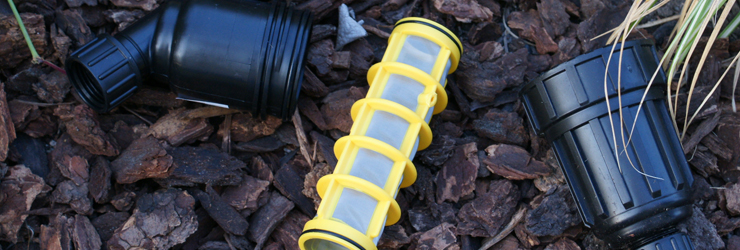An Ounce of Prevention is Worth a Pound of Cure

That is how the old adage goes, and nothing is truer when it comes to drip irrigation systems. Drip irrigation systems are easy to install and do work so well that it’s easy to forget about checking in on them. Often the only time a problem is brought to our attention is when we either see our plants wilting or see a stream of water shooting out somewhere along the tubing. Blame it on Murphy’s law, but problems seem to arise during extended dry periods when plants need water the most.
Where to Check First?
What should be periodically checked in a drip irrigation system to keep things running smoothly? Let’s start with the most overlooked spot: the filter. All of the filters that we sell come with removable screens that can be cleaned. It’s important to open up your filter and check the screen. If you notice buildup on the screen, the screen should be removed and cleaned. Once cleaned, put it back in and close up the filter unit. This short video shows how to access the filter screen in our canister filters.
We can’t stress enough the importance of checking on your filter. It is your first and last line of defense against debris that may enter your system. Cleaning the filter screen removes debris and keeps it from entering your system and clogging your drippers—and if your drippers are not cleanable, this would result in having to replace them completely. That’s not to mention that a filter screen that’s choked with debris will also block water flow through your system, which will impede your system from delivering the amount of water it’s designed to deliver.
Beyond the Filter
Beyond checking the filter, we recommend periodically walking your system while it is running. When walking a system, look at each dripper and make sure that water is coming out—and that it’s coming out at the expected flow. If water is coming out but at a much slower rate, this could be a sign of a dripper that is close to being clogged. If the dripper is cleanable, remove the head and clean out any debris. If it is not cleanable, then it’s up to you to choose to replace it if you feel that the plant is not getting enough water to be healthy. If you don’t clean or replace a dripper that is dripping slower than the other drippers, you will want to make note of it.
While walking your system, be on the lookout for any water that may be leaking out around fittings. As systems pressurize and depressurize, fittings can sometimes begin to slip; additionally, wildlife such as deer moving through the area can dislodge tubing and fittings. It is always recommended to walk your line periodically throughout the season to make sure that the system remains in good working order.
Lastly, as you inspect your system, look for any holes in the tubing or wet spots around tubing where no drippers are present. Rodents like to chew on the tubing, and they can puncture it. A bad spot in tubing is easy to repair with a coupler. However, unexpected holes in tubing will cause the system to depressurize and thereby not function properly. It is good to spot these holes early.
Prevention isn’t exciting and can be easily forgotten, but we do recommend checking in on your drip system at least once or twice a year, in the spring and midsummer. By doing so, you will keep your plants healthier and save time and money.